The Power of Acupuncture in Combat Arts Workout Recovery
It has been in use for over 8,000 years, and remnants of stone needles have been found in archeological sites. The mechanics of acupuncture were not understood or documented by Western science until fairly recently.
Acupuncture has been recommended by the World Health Organization (WHO) as an effective therapy. It uses very fine needles to stimulate strategic points or acupoints located along energy pathways or meridians that run throughout the body. These energy pathways and the exact points to insert needles for stimulating the desired healing effect are well documented and identified within traditional Chinese medicine.[1]
Acupuncture Studied for Decades
Dr. Yoshio Nakatani in 1950 unexpectedly discovered differences in the electrical resistance of the skin of some patients. Certain areas of the skin had poor electrical conductivity and excessive skin resistance.
There was a line that seemed to have increased electrical conductivity and followed the traditional meridian pathway. Dr. Nakatani called this line “Ryodoraku,” which means a strong electrical or conductive pathway. The Ryodoraku lines correspond to classical Chinese meridian pathways. Studies have shown that there are significant interactions between the energy current flows of relative meridians.
The findings show that these interstitial fluid channels form the physiological and morphological basis of the acupuncture meridians described in detail by the ancient Chinese more than 2000 years ago.
A research study proved light flows more efficiently along the meridian than the reference path, demonstrating a 20% or greater difference among all tested participants, which shows how energy in the body also travels. Acupuncture point sites are all located upon intramuscular connective tissue planes. These results support traditional Chinese medical teachings that all meridians are interconnected.
Dr. Kim Bong-Han Discovered Meridians in Early 1960s
Research on acupuncture continued. In the early 1960s, a North Korean surgeon, Kim Bong-Han, discovered a new anatomical system that corresponded to the ancient acupuncture meridians. Kim Bong-Han published research papers on his discovery at that time. Bong-Han’s research was confirmed in 1967 by Japanese researchers Yu and Fujiwara. It took almost 40 years longer for the Stereo-microscope to be developed and utilized to confirm Bong-Han’s original research.
Acupuncture Treatment for Addiction
In 2000, Yale researchers proved that acupuncture was a very promising treatment for cocaine addiction. Their research along with later data shows acupuncture to be very useful in the treatment of cocaine addiction. Later research has confirmed acupuncture’s usefulness in treating addictions in general.
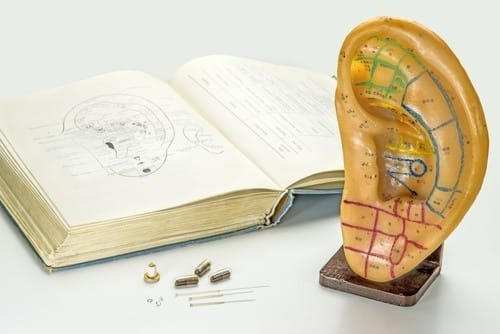
Scientific Evidence Proves Meridians Exist
Thousands of studies have documented the benefits of acupuncture for healing, but this is the first study giving clear scientific proof of the existence of the meridian system, and proving the accuracy of the traditional Chinese medicine system. The meridian system is the basis for acupuncture, electro-acupuncture, and acupressure.
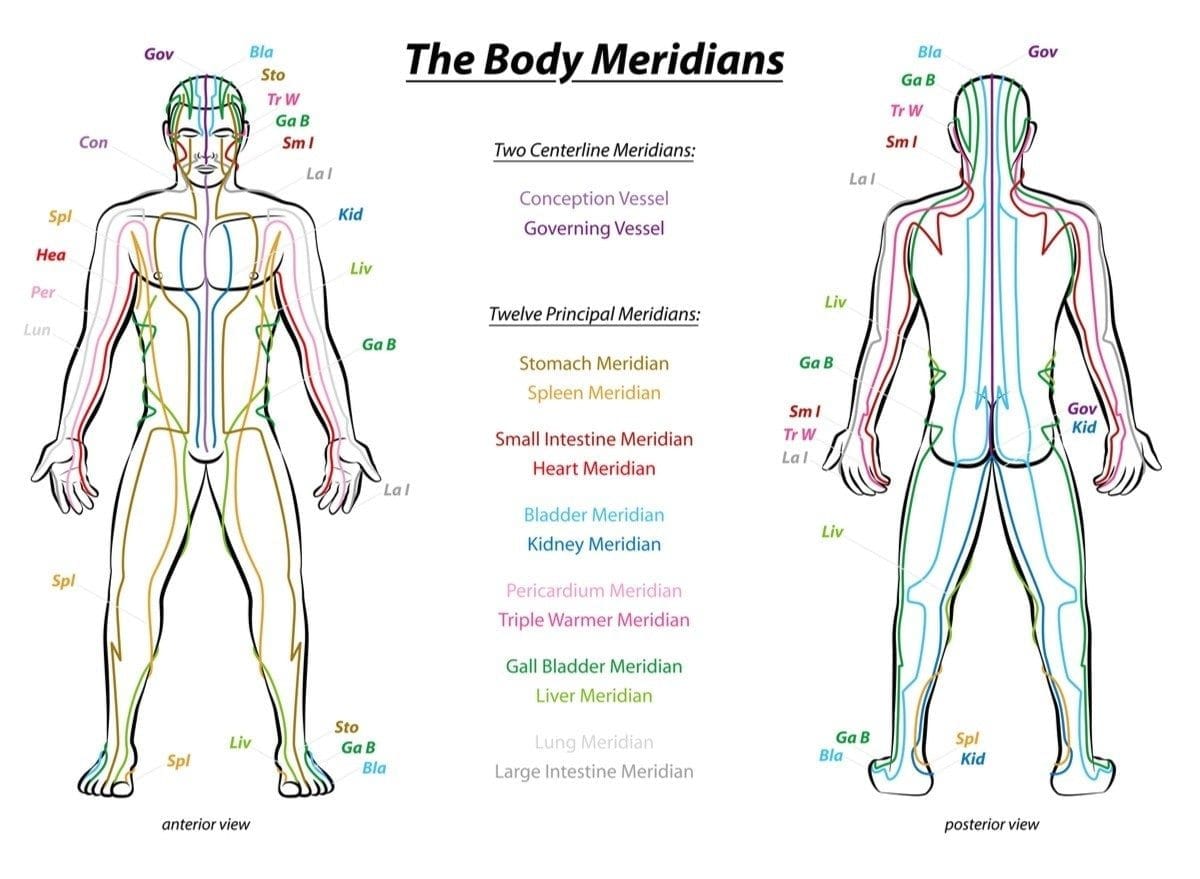
This study is the first to prove meridian lines have a physical basis and flow in channels throughout the body in a way similar to veins, although in a very different manner than veins, can be seen and proven to be working within the body.[6]
This is important information, since Western medicine has ignored and long discounted the entire foundation upon which traditional Chinese medicine rests.
The concept of meridians is not only found in traditional Chinese medicine, but similar concepts exist in Buddhist, Japanese, Hawaiian, Greek, Hebrew, and Ayurvedic medicine also.
Acupuncture Promotes Cell and Tissue Regeneration
Acupuncture is an excellent method of cell regeneration. Many studies have shown the efficiency of acupuncture in promoting cell growth, cell regeneration, and healing. It also promotes tissue regeneration and repair, causes brain cell regeneration and repair after stroke, neural repair, regeneration of nerve fibers and partial functional recovery after spinal cord injury.[7]
"Kung Fu, Tai Chi, and other martial arts utilize the concept of Qi or chi along with basic principles found within traditional Chinese medicine."
Acupuncture Has Benefits That Exceed Recovery
Learn More by Subscribing to Our Newsletter
Traditional Chinese Medicine Blended with Martial Arts
War and medicine have been interconnected in a yin yang aspect for thousands of years, and certain healing knowledge such as bone setting and herbal remedies were developed and perfected on wounded soldiers, prisoners, and on the battlefield. Both medicine and martial arts require awareness and sensitivity, strength and intellectual prowess. Traditional Chinese medical training requires the absorption, understanding, and awareness of utilization of many areas of interlinked knowledge. Martial arts mastery requires the same, sometimes though not always, with a different focus.
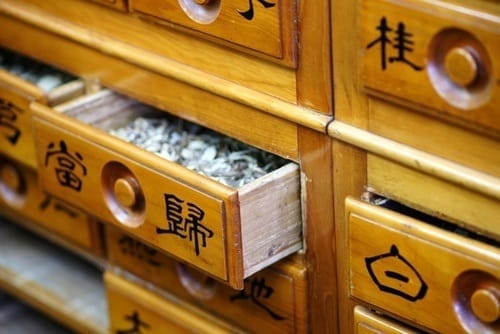
Martial arts training helps establish new neural pathways, ability to focus along with discipline of the self, heightens insight about self and others, develop tactile sensitivity and kinesthetic awareness. It increases delicate muscle control, physical, emotional, and energetic sensitivity, and other abilities useful in the practice of acupuncture.
An acupuncturist needs extremely delicate perceptive abilities to feel the difference in types of tissue through which the incredibly thin structure of an acupuncture needle must pass in order to administer quality care and intuit or feel the client’s energy or chi. The rigorously trained acupuncturist is essentially reading and influencing chi, eliciting a trained medical response to the client’s energy that allows the practitioner to adjust, realign, and heal issues.[8]
Skeptics Step Down
Acupuncture as an alternative medical method has been challenging for many Americans to accept. Acupuncture is an ancient medical science, which makes it even more difficult for modern Westerners to accept because of cultural differences and presentation, notation, and language differences. The basic language and discussion of acupuncture focuses on an energetic relationship within the body that has been difficult for many Westerners to understand.[9]
Western culture has always leaned towards the intellectualized, non-emotional, ‘separate and dissect’ approach. Traditional Chinese medicine teaches interconnection of all parts, the interweaving of all levels of a being, including emotional, physical, intellectual, and energetic body. These differences have fostered skepticism about the accuracy and effectiveness of traditional Chinese medicine in general, and acupuncture in particular, with its discussion of energy flow, meridians, acupuncture points, and chi.
Modern Science Solves Acupuncture Mystery
Recent scientific discoveries have made it clear that acupuncture is a true science, and an ancient healing method of widespread application, extreme accuracy, and insightful efficiency.
Up until now Western science did not have the technological capability of ‘finding’ and ‘seeing’ these tiny, delicate meridian pathways within the human body. Modern science has finally been able to discover and document with precise technology the existence of meridians, energy pathways, acupuncture points, and
other aspects of traditional Chinese medicine. There are now many studies utilizing a wide array of methodologies to prove their existence.
Vitor 'The Phenom' Belfort became the youngest fighter to score a victory inside the octagon. He uses needle therapy and cupping therapy and swears by it. He has said that acupuncture has helped him throughout his career.[10]
Understanding Why Acupuncture Works
Dr. Morry Silberstein of the Curtin University of Technology discovered the physical structure of meridians and acupuncture points. Stereomicroscopic images illustrate meridians as extremely thin nerves called C fibers. Acupuncture points are the places where the C fibers branch.
When an acupuncture needle is inserted into these branching fibers it disrupts this circuit and numbs sensitivity to pain, along with other responses. It has long been known that acupuncture points have a lower electrical resistance than surrounding skin. These C fibers use Merkel cells as ‘messengers’ to send simple sensory information over very long distances.
Light Conducted through Meridians
Another method of proving the existence of meridians and the importance of acupuncture points came in 1991 when Russian researchers proved that the human body conducts light through specific lines corresponding to the places meridian lines are mapped according to traditional Chinese medicine. Light travels through the meridian lines of the body and is emitted only at acupuncture points. Russian researchers at The Institute for Clinical and Experimental Medicine in Novosibirsk, USSR, discovered how the human body conducts light. This light conducting ability of the human body can only occur along the meridians, and can only enter and exit through the acupuncture points.
Dr. Kaznatcheeva, a professor of physics said:
This seems to prove that we have a light transferal system in our body somewhat like optical fiber. It appears that the light can even travel when the light canal is bent, or totally twisted. The light appears to be reflected from the inner surface, appearing to go in some sort of zigzag track. You can explain this through traditional electromagnetic light theory as it is used in optical fiber communications.
A 1992 study in the Journal of Traditional Chinese Medicine and a 2005 study in the Journal of Alternative and Complementary Medicine where moxibustion and infrared thermography were used to trace meridian pathways has confirmed these findings.
This research seems to also prove the existence of a “light body,” which the Russians proved previously with photographic evidence showing the “light body,” essence, or soul leaving the body at the moment of death.
Acupuncture Works by ‘Re-wiring’ the Brain
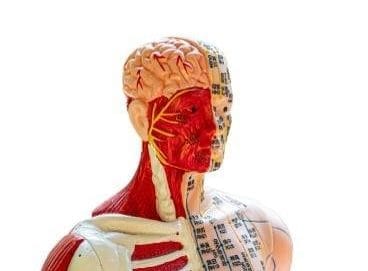
Tests were performed on carpal tunnel syndrome (CTS) patients that proved it re-maps the brain. This negative re-mapping shows up in functional magnetic resonance imaging (fMRI) brain scans as a blurred image of the fingers affected by CPS.
Acupuncture improved symptom relief of CPS, but it also changed the fMRI brain scan results to show a normal, sharper image of fingers, illustrating how acupuncture ‘re-wired’ the brain back to normal, along with improving local blood flow to the median nerve in the wrist.
When the Needle is Inserted
Answers have been discovered on certain mechanical aspects of acupuncture, but these do not tell the whole picture, much as knowing the ingredients in a cake do not quite give you cake.
Exactly how acupuncture works is not a simple one-to-one answer of the type so treasured by Western science.
Acupuncture works on an incredibly intricate and deeply interconnected level within the body’s biological web, causing subtle shifts in energy intensities and pathways, and causing changes in the brain, which then trigger hormonal releases, physical, mental, and emotional alterations.
There has been much clarification as to what happens when the needle is inserted and manipulated. One effect is an immediate, significant increase in nitric oxide, increasing blood flow and helping provide an immediate and lasting analgesic or pain relieving effect.[13]
Triggering the Relaxation Response
The interaction between the connective tissue and the relaxation response was researched in the early 2000s when Dr. Helene M. Langevin MD used ultrasound to examine what happens under the skin when acupuncture needles were inserted into acupuncture points. The study demonstrated clearly that mere insertion of the needles was not enough to trigger the body’s response, but actual manipulation of the needles was required.
The research team found that once acupuncture needles were inserted and manipulated slightly, connective tissue immediately hooked around the needle, causing this tissue to stretch slightly as the needle twisted, which induced fibroblast cells within connective tissue to change their shape.
Fibroblast cells even several centimeters away from the needle responded with assuming a large, flat shape and reorganization of their internal cytoskeleton, reshaping to be large and flat, remaining this way until the needle left the skin. This fibroblast reorganization explains the relaxation response induced during acupuncture, along with its pain relieving effects.
Releasing Trigger Points and Pain
Acupuncture gives relief for painful musculo-skeletal conditions through a variety of responses, including release of trigger points. Trigger points are sensitive spots or areas of tension. They are involved in nearly every pain syndrome. There may not always be pain where there is a trigger point, but there will probably be one or more trigger points where there is pain. These trigger points may show up as a ‘knot’ or tight bump. Acupuncture increases circulation, induces the relaxation response, increases nutrient flow to the problem area, and basically ‘unknots’ muscles at trigger points.[14]
Acupuncture Taught to U.S. Military Doctors for Use in Iraq and Afghanistan
Dr. Richard Niemtzow MD, PhD, MPH and editor of Medical Acupuncture has taught acupuncture for pain relief to American Air Force doctors for use in Afghanistan and Iraq. Use of acupuncture for battlefield conditions blocks severe pain for several days, and is called “Battlefield Acupuncture.” Dr. Niemtzow teaches doctors to insert very tiny semi-permanent needles at specific acupoints on the skin of the ear. These tiny needles then block pain signals from reaching the brain, resulting in immediate and lasting pain relief that lasts.
This variation on acupuncture technique is amazingly versatile, allowing wounded soldiers virtually instant pain relief in situations where it might be impossible using other methods.
This is one of the fastest pain attenuators in existence," said Dr. Niemtzow, who is the Consultant for complementary and alternative medicine for the Surgeon General of the Air Force, & is affiliated with Uniformed Services University of the Health Sciences in Bethesda. "The pain can be gone in five minutes."
This begs the question of why this simple, cheap, painless, and nonaddicting method is not utilized in every doctor’s office, hospital, school, and clinic across the nation.
Acupuncture Affects the Brain
Acupuncture basically deactivates areas in the brain that are responsible for pain perception. These areas also get activated by stress and pain in addition to negative emotions, and deactivating them lowers negative response to stimuli, allowing the body to relax and heal. Acupuncture is true therapy and medicine since it actually corrects a dysfunction that causes pain, instead of merely blocking pain or masking symptoms. Acupuncture stimulates the parasympathetic system, aiding in relaxation so patients often will sleep better after treatment.[16]
Blackzilians Professional MMA Fighter Irwin 'The Beast' Rivera gives a rave review for Acupuncture, and Blackzilians UFC and MMA Fighter call acupuncture a secret to great sports performance and top conditioning.[17]
Acupuncture Treatment for Martial Arts Injuries
There are many injuries commonplace within martial arts, MMA, and UFC training and competition. Regular prophylactic acupuncture treatments are highly recommended in order to reduce injury risk. When acute or chronic injury pain occurs, or trigger points appear, acupuncture is an excellent treatment. Common martial arts injuries and pain can occur from martial arts training, sparring, and competition include:
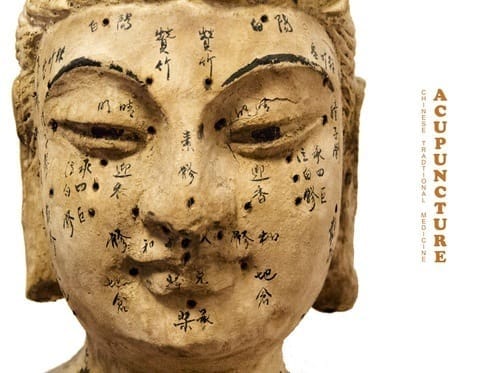
Acupuncture for Acute Pain, Injury, and Preventive Care
Acupuncture tends to be a process. It requires more than one session when dealing with extremely severe pain. Acupuncture is a system of continuous fine tuning, tweaking the body’s physical and energetic systems with small realignments, similar to giving a car regular tune-ups keeps it running better.
Ideally, acupuncture is used in conjunction with traditional Chinese medical and other techniques on a consistent basis to achieve and retain a top level physique, and help prevent injury through premium care.
Rigorous training pressures, along with the physical and emotional intensity required of serious martial artists, MMA, and UFC fighters can create weakness and injury if not given consistent physical support to mitigate them. Sports injuries often occur because of tension building over time in a vulnerable area that finally gives out.
The martial artist who always leads with the right hook, typically uses the left leg roundhouse for TKOs, or other ‘signature’ moves that place extra stress on any one part of the body means extreme tension or intensive strain may occur there.
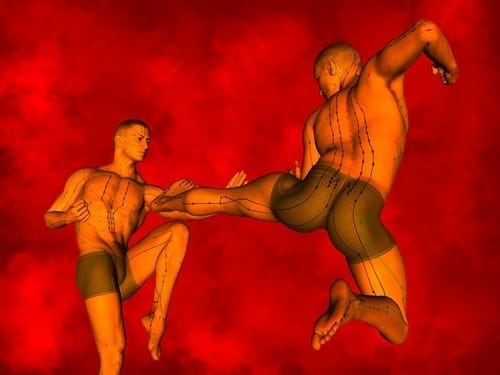
This is why prophylactic or ‘weekly health insurance’ care treatments make all the difference when it comes to relieving stress and preventing injury, rather than always doing acute care after the fact, risking serious harm to body and enforced time off from training and fighting schedules. Particularly for those under rigorous training pressures, weekly acupuncture treatments will be essential, as they will induce the relaxation response, release emotional pressure, support recovery and improve sleep.
Acupuncture gives reliable and successful treatment options for those difficult to identify mystery issues such as low energy, low emotional state, running out of gas too soon, lacking zest, inability to sleep or sleeping too much, or any number of details that may crop up and disrupt training schedules.[18]
Electroacupuncture
Electroacupuncture is a subset of acupuncture, and it works in a similar manner. It is often used in conjunction with traditional acupuncture, and stimulating more than one site can have a synergistic effect. Acupuncture uses handheld needle application and manipulation, while electroacupuncture therapy uses acupuncture needles together with the application of a pulsating electrical current in order to stimulate acupoints.
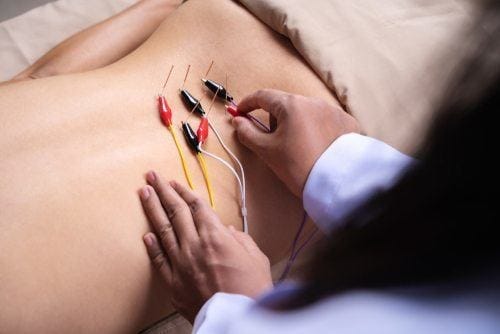
This treatment is not painful. Typically the patient feels only a slight tingling. The intensity of frequency is adjusted for each patient in accordance with their tolerance level. In general, low frequency and high intensity is used for pain and chronic diseases, while a high frequency with lower power is used for acute pains and certain other diseases. Usage type will be decided by the acupuncturist after examination.
Don't Know Which Recovery Techniques are the Best & Why?
Let Us Teach You About the Different Options & Which Ones are Best for Your Specific Situation.
UFC world champion fighter Joanna Jedrzejczyk works with an acupuncturist to maintain optimal fitness and physical wellness. She defended her title against the tough Brazilian Jessica Andrade in Dallas at UFC 211 and won. Jedrzejczyk believes to stay champion and in optimal health she has the help of an acupuncturist, nutritionist and a wellness clinic.
Electroacupuncture in Use Since 1934
Electroacupuncture was developed in China in 1934 as an alternative and supplement to hand manipulation of needles. Electroacupuncture uses the meridian lines and same acupuncture points as traditional acupuncture, and the same points are stimulated during treatment.
For electroacupuncture, however, the needles are inserted at points along the body necessary for stimulating the proper areas, but then these needles are attached by wires to an electrical generator that sends gentle electric pulses through small clips.
This extremely site-specific electrical current can be used in conjunction with, or instead of, traditional acupuncture therapy. It is an alternative method that deeply stimulates acupoints. Electroacupuncture can have strong advantages over traditional acupuncture in treating certain illnesses and issues.
Some great benefits provided by electroacupuncture over more traditional acupuncture include: shorter treatment times and more stimulation around the acupoint site and through needles. Electroacupuncture gives very quick results that tend to last longer. This method helps strengthen a weak immune system, reduce pain, increase blood circulation, and promote relaxation.
Both regular and electro acupuncture help relieve chronic pain, neurological diseases, and headaches.
It is excellent for back pain, stress, anxiety, and depression. Electroacupuncture and traditional acupuncture aid in regenerating healthy neural tissues, including cartilage, degenerated spinal discs, acute tendon injury, arthritic degenerative spinal conditions, helps with collagen matrix, and restoration in osteoarthritic degeneration of the knee.
Electroacupuncture specifically can provide relief with shoulder pain, myofascial pain, carpal tunnel syndrome, fibromyalgia, tennis elbow, facial neuralgia, and dysmenorrhea.
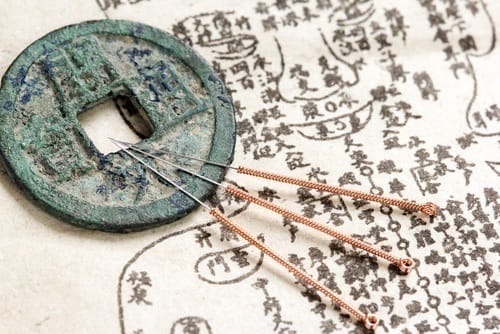
Researchers at Rutgers University reported electroacupuncture may relieve severe inflammation.
Electroacupuncture with Herbs Regenerates Cartilage
Electroacupuncture in conjunction with Chinese herbal treatments such as Frankincense (Boswellia) and Curcumin promote cartilage regrowth while simultaneously inhibiting cartilage degeneration.
Acupuncture Cautions
Occasionally side effects will appear such as feelings of tickling, heat, bruising, and rarely, mild pain. Some contraindications for electroacupuncture include having a pacemaker, epilepsy, cardiovascular accidents, and heart disease. Never use electroacupuncture when any of these issues or conditions are present.
Always use a professional acupuncturist. A licensed acupuncturist studies for years to perform these techniques properly. Also, acupuncture needles are much finer, allowing for more comfortable treatment of trigger points per session than can be utilized with injection or even manual release.
This is important because when several different acupoints are stimulated simultaneously, it has a synergistic effect, making the therapy more powerful overall.
Certain other professions may offer weekend courses in acupuncture, which is inadequate. There are also significant differences between schools, their specific needling techniques, and duration of training programs. Steer clear if in doubt, and research practitioners to ensure receiving the finest professional care.
